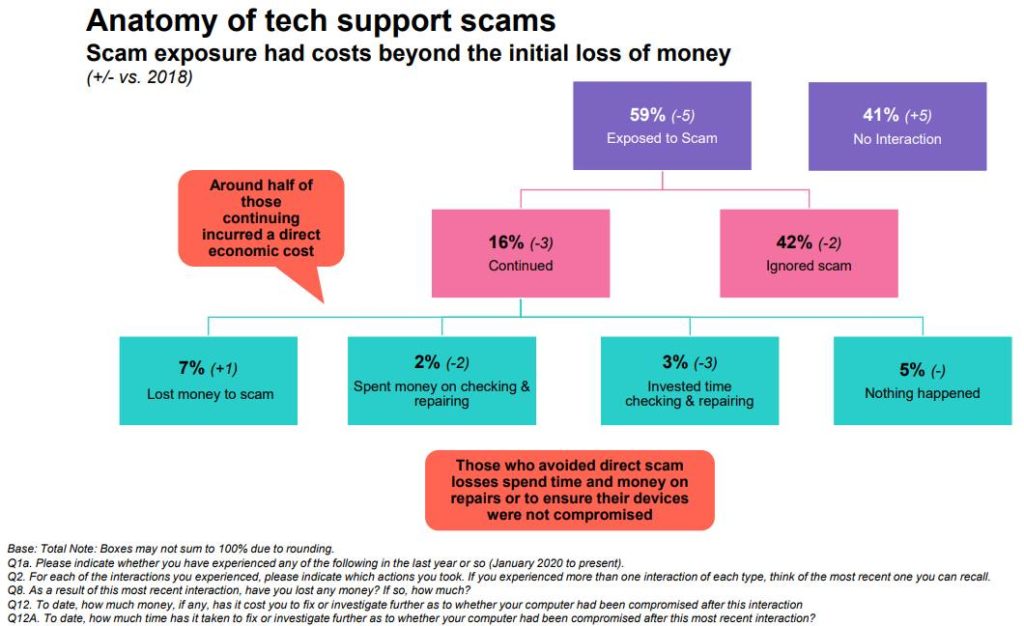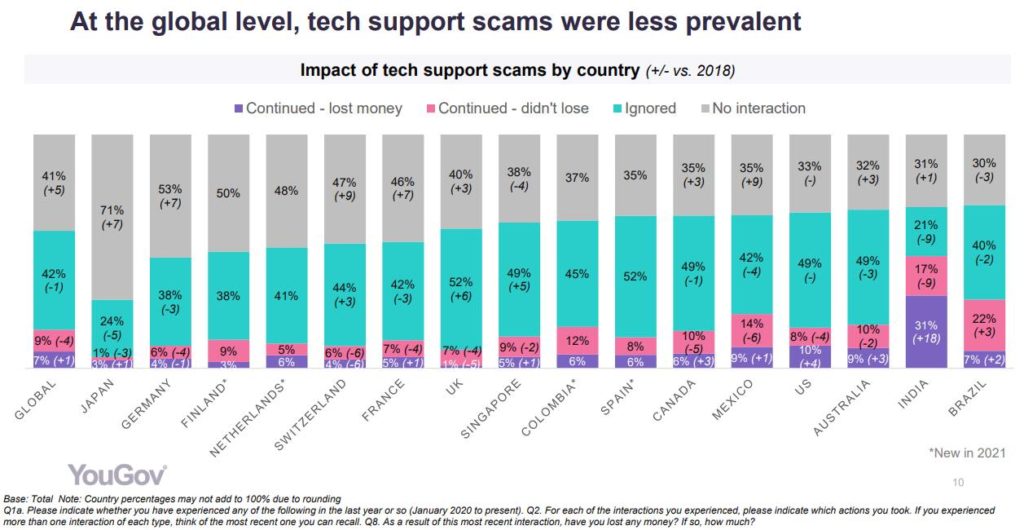The 2021 Global Tech Support Scam Research revealed an overall fall in scam encounters, from 64% in 2018 to 59% in 2021.
The study, conducted by YouGov and commissioned by Microsoft, noted that 16% of those falling victim were tricked into continuing with the scam, a three-point decrease from 2018.

Microsoft angle
According to Microsoft, the company receives about 6,500 complaints globally from people who have been the victim of a tech support scam. The good news is that the figure is down by half from prior years.
Mary Jo Schrade, assistant general counsel, regional lead, Microsoft Digital Crimes Unit Asia, said: “Tech support scams are perpetrated globally and target people of all ages. While we do see progress made in the percentage of people who declined to engage with the scammers, there is continued need to monitor and address how the attacks are evolving.”
She acknowledged that tactics used by fraudsters to victimize users online have evolved over time, from pure cold calling to more sophisticated ploys, such as fake “pop-ups” displayed on people’s computers.
“Across the diverse region of Asia Pacific, we are seeing attack rates vary according to demographics and habits – yet tech support scams continue to affect all countries. We are committed to online safety and hope these survey findings will help to better educate people so they can avoid becoming victims of these scams,” she continued.
The decline in scams – what does it mean?

The global fall in scam exposure rates between 2018 to 2021 was largely driven by a reduction in scams involving pop-ups (-8%) as well as those with redirects to websites (-7%).
This trend was also reflected in the region. Japan recorded the greatest decrease among the APAC markets surveyed, at a 12-point drop for encounters relating to pop-ups and a five-point drop for website scams across the same period. Only 5% of those Japanese consumers surveyed proceeded to interact with a scammer.
Australia, India, and Singapore also saw declines of four, five and one points around pop-ups respectively, and two, one and three points around website scams, respectively.
Australia (19%) and Singapore (14%) saw rates on par with the rest of the world.
Consumers in India were three times more likely to continue with a scam interaction (49%) than the global average (16%).
Increasing effectiveness of scams
On a global level, there was a one-point increase in consumers losing money during the scam interaction in 2021 (7%) as compared with 2018 (6%).
Consumers in the APAC markets with Japan (3%) and Singapore (5%) recorded a one-point increase from 2018 to 2021; Australia (9%) recorded a three-point increase during the same period. More significantly, about a third of consumers in India (31%) who continued with such scams lost money as a result, an increase of 17 points from 2018 (14%).
Scammers pick up on computer problems
Computer problems are the most common issue during scam interactions
Among those who continued with a scam, the most common issue experienced globally during the interaction was computer problems (30%), followed by compromised passwords (23%), and fraudulent use of credit/debit/store cards (18%).
Following a computer-related scam, 77% in Australia and 82% in India surveyed spent time checking and repairing their computer, slightly higher than the global average of 76% in 2021. It is crucial to carry out checks, as some scammers are known to install malware on computers, allowing them to maintain remote access to people’s computers long after the victims believed the interaction was terminated.
Worrying trend
“Tech support scams will remain an industry-wide challenge until sufficient people are educated about these scams and can avoid them. The best way consumers in Asia-Pacific can protect themselves is to learn about these scammers are targeting people, be suspicious of any unsolicited contact from purported tech company employees and avoid letting people they do not know remotely access their computers,” added Schrade.





